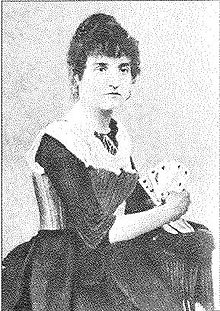I came across the Tarot card image to the right this evening, and it reminded me of Maddalena Taluti, the woman who dispensed so many of the mysteries of Stregheria to researcher and author Charles Godfrey Leland for his works. I can picture is being her perhaps when she was younger, as she was thought of as having an "Etruscan look."
Then I came across a long biography, and I wanted to post them. The story of Charles Leland and Maddalena would make a great film if they did it right; not try to sensationalize or trivialize it, or add anything silly to it, or make any type of "grand" unrelated "statement." It could be perfect. In any case, we should never forget her. Also, of course, Charles Leland. Where would be be without him!?
Back when I was living on the edge of the Santa Cruz Mountains, I named a lot of things over years; not intending to "name everything," but it just occurred naturally. I named part of a trail on a lower meadow of sorts, as "Maddy's Grove." Now I'm living far away from there. I wonder if anyone there thinks of that name I gave when on that trail?
You can always just take a smooth stone, paint it, and paint someone's name who's passed away as something of a marker, and place it in a garden or anywhere. You might paint on a symbol or numbers and letters, anything that reminds you of them, or a symbol of how you may perceive them if you never knew them. Also, you could carve or have something made to put on the front of a flower box, or just make something to sink into the soil with "In Loving Memory of...".. or something else if the person was just a hero of yours and you didn't know them.
It's curious to me that Maddalena lived in Genoa during her latter days. A city which had such a long profound link to San Francisco, which in turn would be perhaps something of an invisible bridge to "Maddy's Grove."
************
Maddalena “Margherita” Taluti (findagrave.com)
Birth: unknown
Rocca San Casciano, Provincia di Forli, Emilia-Romagna, Italy
Death: unknown
Genoa, Città Metropolitana di Genova, Liguria, Italy
Burial: Burial Details Unknown
In the history of Witchcraft there is perhaps no figure more mysterious than the Witch known as Maddalena. As described by folklorist Charles Leland in several of his books, Maddalena was an Italian fortune teller and Witch. She supplied Leland with a great deal of Italian Witch lore including the text Leland later published as the Gospel of the Witches in 1899. Maddalena was also known to folklorists Roma Lister and Lady de Vere (to who she was introduced as "Margherita").
New findings related to Maddalena have recently come to light through some research I conducted at the Library of Congress. At the Pantheacon conference, on February 17th, 2008, I presented a copy of a page from The International Folklore Congress: Papers and Transactions, 1891. On page 454, Maddalena's name appears as a contributor to an exhibit presented by Charles Leland. Her name is given as Maddalena Taluti. In the modern Pazzaglini translation of Aradia, contributing writer professor Robert Mathiesen wrote that he believed Maddalena's last name to be Talenti. In light of new findings he is incorrect, but he does state that her name was almost illegible in the document he examined.
According to Leland, in his book Etruscan Roman Remains, Maddalena was originally from the town of Rocca Casciano, which is now called Rocca San Casciano. It is located in the Province of Forli-Cesena in the Italian region of Emilia-Romagna. She reportedly traveled a great deal, making a living telling fortunes and selling charms. According to Leland, Maddalena claimed to have been trained in a family tradition of Italian Witchcraft, which was passed on to her by aunts and by her step-mother.
The Aradia material obtained for Leland differs greatly from the material that Maddalena had previously supplied to him. In the book Etruscan Roman Remains, Leland describes the Witches of Italy as being both good and bad. By contrast the Aradia material portrays Witches in a negative light. It is noteworthy that he describes a group that he calls the "beautiful witches of Benevento." Concerning Maddalena herself, Leland describes her as:
"a young woman who would have been taken for a Gypsy in England, but in whose face, in Italy, I soon learned to know the antique Etruscan, with its strange mysteries, to which was added the indefinable glance of the Witch. She was from the Romagna Toscana, born in the heart of its unsurpassingly wild and romantic scenery, amid cliffs, headlong torrents, forests, and old legendary castles. I did not gather all the facts for a long time, but gradually found that she was of a Witch family, or one whose members had, from time to immemorial, told fortunes, repeated ancient legends, gathered incantations, and learned how to intone them, prepared enchanted medicines, philtres, or spells. As a girl, her Witch grandmother, aunt, and especially her stepmother brought her up to believe in her destiny as a sorceress, and taught her in the forests, afar from human ear, to chant in strange prescribed tones, incantations or evocations to the ancient gods of Italy, under names but little changed, who are now known as folletti, spiriti, fate, or lari - the Lares or household goblins of the ancient Etruscans."
The tradition that Maddalena most likely practiced is reflected in Leland's books Etruscan Roman Remains, Legends of Florence, and Legends of Virgil. The portrayal of Witches and Witchcraft in Leland's Gospel of Aradia does not reflect the same image as his earlier works. This is another indication that the material came from a system outside of Maddalena's own knowledge and experience.
A letter from Leland to his niece, which I presented a copy of at the Pantheacon conference, describes Maddalena performing a ritual in which she invokes a goddess and a god. During the invocation, Maddalena reportedly went into convulsions, and Leland had to send out for two pints of brandy in order to restore her back to normal. This speaks to Maddalena as a genuine practitioner of the Old Religion. Leland goes on in the letter to say that if ever there was a true depiction of the witch, Maddalena demonstrated it through her magic.
In the book Aradia, Leland notes that he lost touch with Maddalena after receiving a letter from her that she was marrying her shoemaker (Lorenzo Bruciatelli) and immigrating to America. As a result of this comment, the view has been held that Leland never heard from Maddalena again, and what became of her is unknown. Fortunately, another recent discovered by me came in the form of a letter found in the archives of the Library of Congress (buried in a stack of old letters). The letter, written by Leland to his niece, mentions that Maddalena did not move to America, but left her husband and went to Genoa to make a living there on her own. She wrote to Leland letting him know what happened, and she asked him if he could send her ten francs as she was in a difficult financial situation. He complied, but it seems that the two never met again after this communication.
Gravesite Details
Maddelna, not giving much of her information out, more than likely had a formal burial, but the where abouts are unknown.
************
Another's sentiment
"Amore mio, grazie per la tua conoscenza, sempre nella memoria."
.











